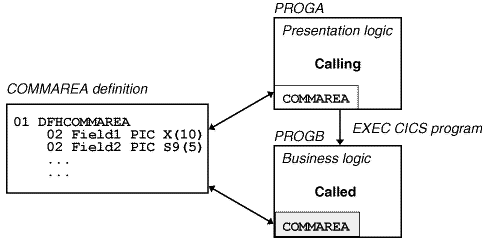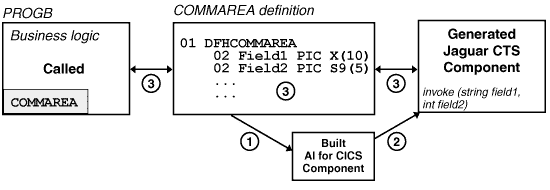

Chapter 2 Getting Ready to Use AI for CICS
This section covers the following topics:
Modern CICS programs store presentation logic and business logic in separate programs. When the two programs need to communicate with each other, they must pass data back and forth in a COMMAREA, which is a block of contiguous memory.
Because the CICS programs must agree on the format and use of the data definitions in the COMMAREA, this area is usually mapped by a single COBOL data definition that is included in both participating programs.
The COMMAREA (data definition file) can be stored as follows:
![]() See § for
more information about how to import the COMMAREA from each of these
stored locations.
See § for
more information about how to import the COMMAREA from each of these
stored locations.
Files imported into the AI for CICS Component Builder must contain a COMMAREA for the CICS program you want and nothing else , as shown in the following example:
01 DFHCOMMAREA.
02 CA-RETCODE PIC 9(8) COMP.
02 CA-SWSECI1-COMMAREA.
05 CA-NUMBER-OF-ROWS PIC 9(4) COMP.
05 CA-ERROR-MESSAGE PIC X(10).
05 CA-CURRENT-DATE PIC X(8).
05 CA-CURRENT-TIME PIC X(8).
05 CA-CICS-ABSTIME PIC S9(15) COMP-3.
05 CA-ROW-DATA OCCURS 1 TO 1818 TIMES
DEPENDING ON CA-NUMBER-OF-ROWS.
10 CA-ROW-NUMBER PIC S9(4) COMP.
10 CA-ROW-NUM-AS-CHAR PIC X(6).
10 CA-DATA PIC X(10).
![]() When you move a COMMAREA to the workstation, be sure
you remove all REDEFINES clauses
and field declarations following REDEFINES clauses.
When you move a COMMAREA to the workstation, be sure
you remove all REDEFINES clauses
and field declarations following REDEFINES clauses.
To communicate input and output information, the "calling" program typically sets input fields in the COMMAREA and calls another CICS program, passing the COMMAREA to it. The "called" program then puts the results of this operation back into fields in the COMMAREA and returns execution to the calling program. This makes the output for the called program available to the calling program through the COMMAREA.
Figure 2-1 shows this process: PROGA (the presentation logic) invokes PROGB (the business logic) and passes the COMMAREA to it, thus defining the input and output definitions that they will share.

The following figure shows how AI for CICS maps the data definitions from the COMMAREA.

Following are the basic steps in this process:
This section describes how to make data definitions in the COMMAREA available on the workstation so that AI for CICS can use them. Following are descriptions based on how you import the COMMAREA:
If the COMMAREA is embedded in source code, follow these steps to make it available to AI for CICS:
In mainframe applications, many sections of program code are common to multiple programs, such as file layouts, communication area layouts, common data definitions, and file descriptions. Most compilers are able to include code fragments from a library at compile time.
In COBOL, libraries of these code fragments are called copybooks, and the individual members within them are called copybook members.
Follow these steps to make the copybook member available to AI for CICS:
![]() If your site uses code management utilities such as CA-LIBRARIAN or PANVALET,
contact your mainframe systems administrator for information on
locating copybooks in your environment.
If your site uses code management utilities such as CA-LIBRARIAN or PANVALET,
contact your mainframe systems administrator for information on
locating copybooks in your environment.
COPY abcd
![]() If the copybook member contains more than the COMMAREA definitions,
edit the downloaded file so that it contains only the COMMAREA.
If the copybook member contains more than the COMMAREA definitions,
edit the downloaded file so that it contains only the COMMAREA.
Follow these steps to make the COMMAREA available to AI for CICS:
![]() If the file contains more than the COMMAREA definitions,
edit the downloaded file so that it contains only the COMMAREA.
If the file contains more than the COMMAREA definitions,
edit the downloaded file so that it contains only the COMMAREA.
| Copyright © 1999 Sybase, Inc. All rights reserved. |

| |